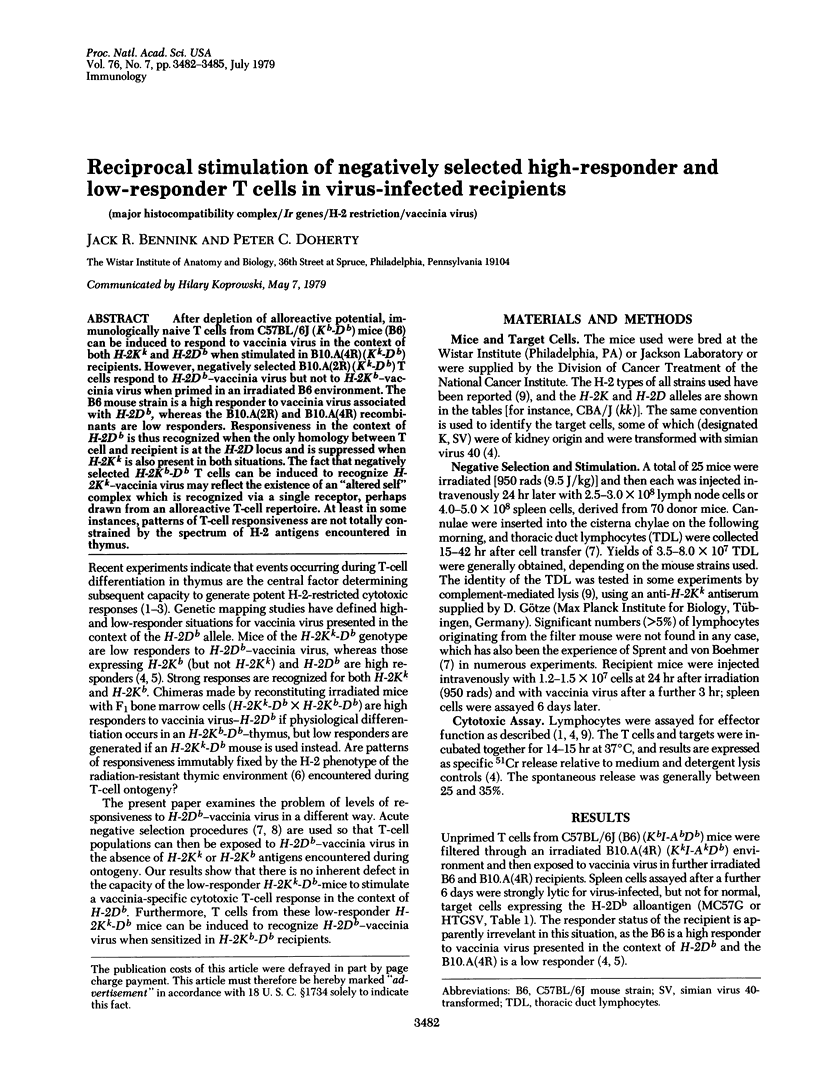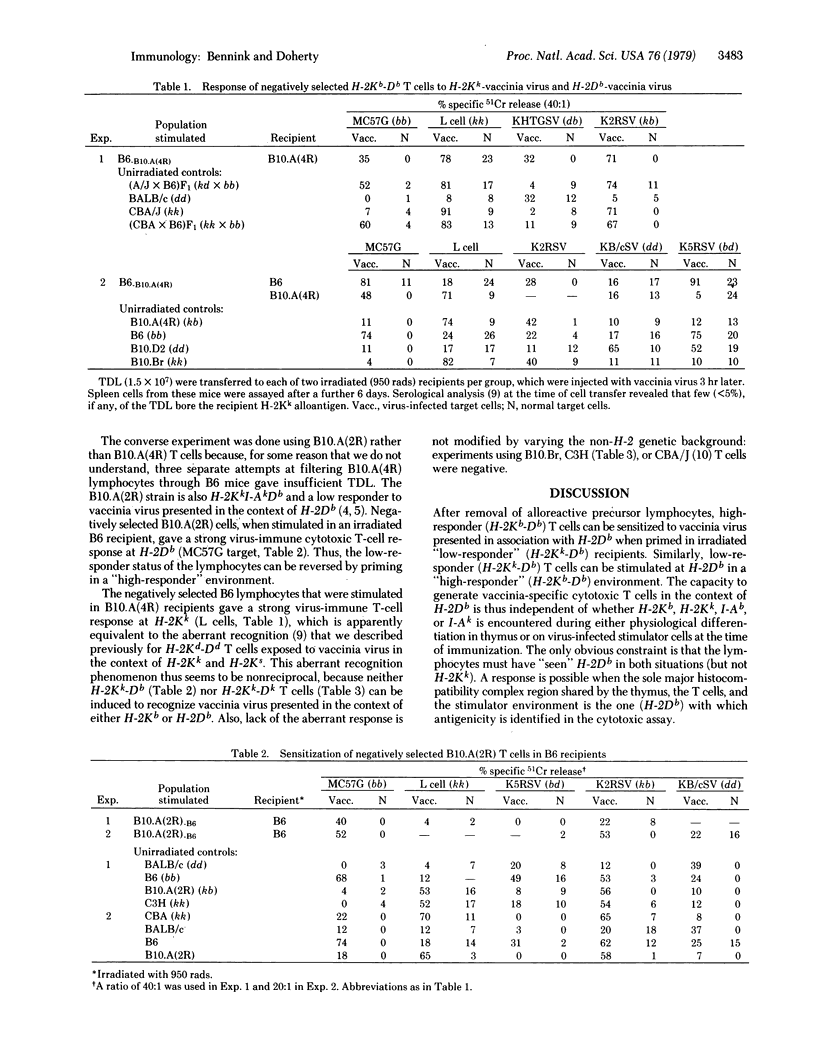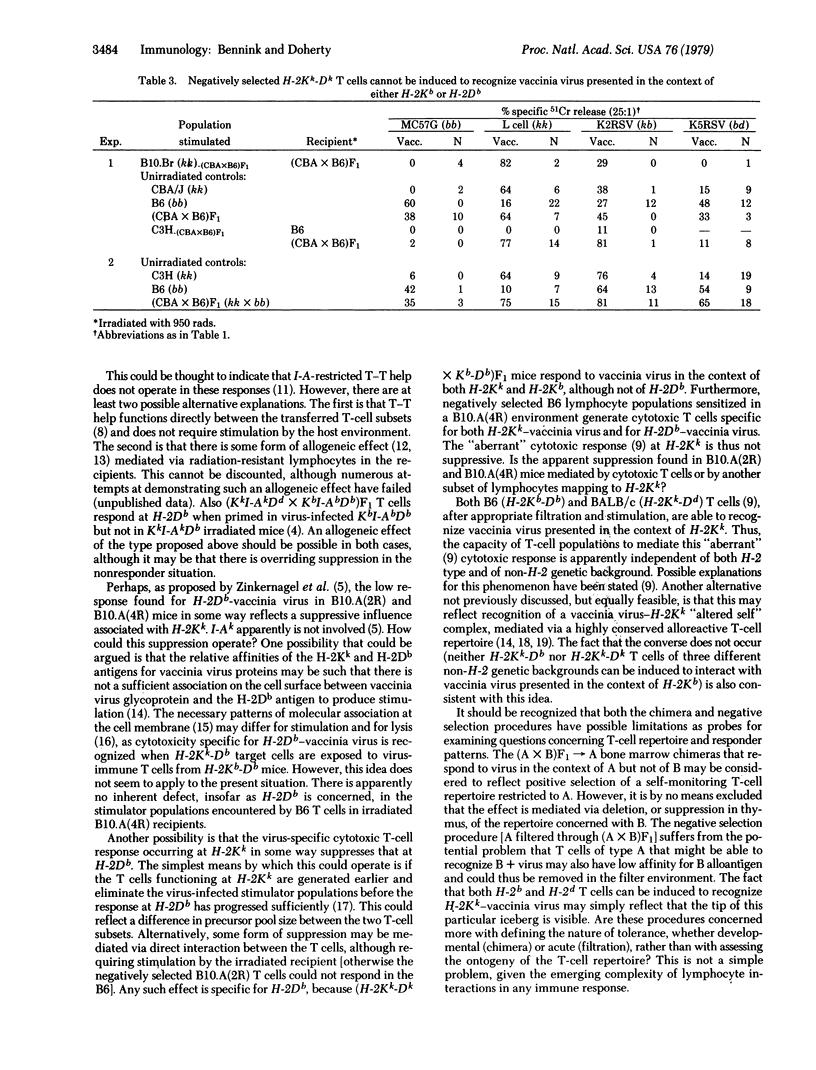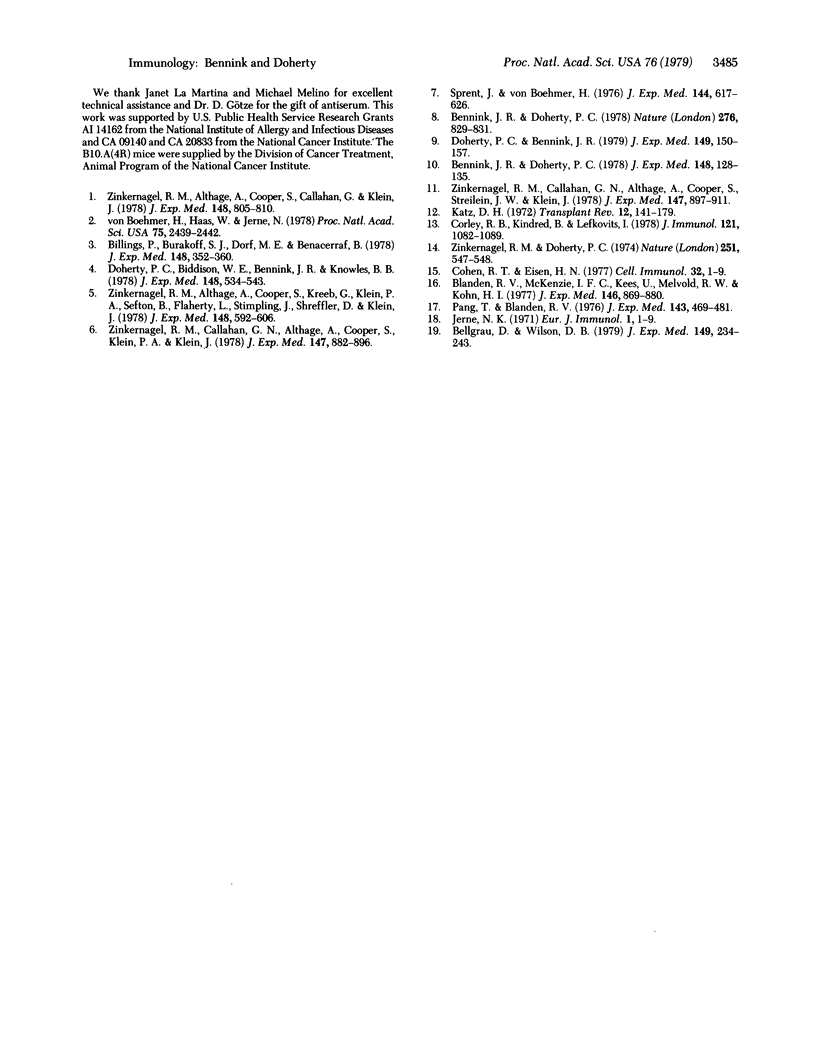Abstract
After depletion of alloreactive potential, immunologically naive T cells from C57BL/6J (Kb-Db) mice (B6) can be induced to respond to vaccinia virus in the context of both H-2Kk and H-2Db when stimulated in B10.A(4R) (Kk-Db) recipients. However, negatively selected B10.A(2R) (Kk-Db) T cells respond to H-2Db-vaccinia virus but not to H-2Kb-vaccinia virus when primed in an irradiated B6 environment. The B6 mouse strain is a high responder to vaccinia virus associated with H-2Db, whereas the B10.A(2R) and B10.A(4R) recombinants are low responders. Responsiveness in the context of H-2Db is thus recognized when the only homology between T cell and recipient is at the H-2D locus and is suppressed when H-2Kk is also present in both situations. The fact that negatively selected H-2Kb-Db T cells can be induced to recognize H-2Kk-vaccinia virus may reflect the existence of an "altered self" complex which is recognized via a single receptor, perhaps drawn from an alloreactive T-cell repertoire. At least in some instances, patterns of T-cell responsiveness are not totally constrained by the spectrum of H-2 antigens encountered in thymus.
Full text
PDF



Selected References
These references are in PubMed. This may not be the complete list of references from this article.
- Bellgrau D., Wilson D. B. Immunological studies of T-cell receptors. II. Limited polymorphism of idiotypic determinants on T-cell receptors specific for major histocompatibility complex alloantigens. J Exp Med. 1979 Jan 1;149(1):234–243. doi: 10.1084/jem.149.1.234. [DOI] [PMC free article] [PubMed] [Google Scholar]
- Bennink J. R., Doherty P. C. Different rules govern help for cytotoxic T cells and B cells. Nature. 1978 Dec 21;276(5690):829–831. doi: 10.1038/276829a0. [DOI] [PubMed] [Google Scholar]
- Bennink J. R., Doherty P. C. T-cell populations specifically depleted of alloreactive potential cannot be induced to lyse H-2-different virus-infected target cells. J Exp Med. 1978 Jul 1;148(1):128–135. doi: 10.1084/jem.148.1.128. [DOI] [PMC free article] [PubMed] [Google Scholar]
- Billings P., Burakoff S. J., Dorf M. E., Benacerraf B. Genetic control of cytolytic t-lymphocyte responses. II. The role of the host genotype in parental leads to F1 radiation chimeras in the control of the specificity of cytolytic T-lymphocyte responses to trinitrophenyl-modified syngeneic cells. J Exp Med. 1978 Aug 1;148(2):352–359. doi: 10.1084/jem.148.2.352. [DOI] [PMC free article] [PubMed] [Google Scholar]
- Blanden R. V., McKenzie I. F., Kees U., Melvold R. W., Kohn H. I. Cytotoxic T-cell response to Ectromelia virus-infected cells. Different H-2 requirements for triggering precursor T-cell induction or lysis by effector T cells defined by the BALB/c-H-2db mutation. J Exp Med. 1977 Sep 1;146(3):869–880. doi: 10.1084/jem.146.3.869. [DOI] [PMC free article] [PubMed] [Google Scholar]
- Corley R. B., Kindred B., Lefkovits I. Positive and negative allogeneic effects mediated by MLR-primed lymphocytes: quantitation by limiting dilution analysis. J Immunol. 1978 Sep;121(3):1082–1089. [PubMed] [Google Scholar]
- Doherty P. C., Bennink J. C. Vaccinia-specific cytotoxic T-cell responses in the context of H-2 antigens not encountered in thymus may reflect aberrant recognition of a virus-H-2 complex. J Exp Med. 1979 Jan 1;149(1):150–157. doi: 10.1084/jem.149.1.150. [DOI] [PMC free article] [PubMed] [Google Scholar]
- Doherty P. C., Biddison W. E., Bennink J. R., Knowles B. B. Cytotoxic T-cell responses in mice infected with influenza and vaccinia viruses vary in magnitude with H-2 genotype. J Exp Med. 1978 Aug 1;148(2):534–543. doi: 10.1084/jem.148.2.534. [DOI] [PMC free article] [PubMed] [Google Scholar]
- Jerne N. K. The somatic generation of immune recognition. Eur J Immunol. 1971 Jan;1(1):1–9. doi: 10.1002/eji.1830010102. [DOI] [PubMed] [Google Scholar]
- Katz D. H. The allogeneic effect on immune responses: model for regulatory influences of T lymphocytes on the immune system. Transplant Rev. 1972;12:141–179. doi: 10.1111/j.1600-065x.1972.tb00055.x. [DOI] [PubMed] [Google Scholar]
- Pang T., Blanden R. V. Regulation of the T-cell response to ectromelia virus infection. I. Feedback suppression by effector T cells. J Exp Med. 1976 Mar 1;143(3):469–481. doi: 10.1084/jem.143.3.469. [DOI] [PMC free article] [PubMed] [Google Scholar]
- Sprent J., von Boehmer H. Helper function of T cells depleted of alloantigen-reactive lymphocytes by filtration through irradiated F1 hybrid recipients. I. Failure to collaborate with allogeneic B cells in a secondary response to sheep erythrocytes measured in vivo. J Exp Med. 1976 Sep 1;144(3):617–626. doi: 10.1084/jem.144.3.617. [DOI] [PMC free article] [PubMed] [Google Scholar]
- Zinkernagel R. M., Althage A., Cooper S., Callahan G., Klein J. In irradiation chimeras, K or D regions of the chimeric host, not of the donor lymphocytes, determine immune responsiveness of antiviral cytotoxic T cells. J Exp Med. 1978 Sep 1;148(3):805–810. doi: 10.1084/jem.148.3.805. [DOI] [PMC free article] [PubMed] [Google Scholar]
- Zinkernagel R. M., Althage A., Cooper S., Kreeb G., Klein P. A., Sefton B., Flaherty L., Stimpfling J., Shreffler D., Klein J. Ir-genes in H-2 regulate generation of anti-viral cytotoxic T cells. Mapping to K or D and dominance of unresponsiveness. J Exp Med. 1978 Aug 1;148(2):592–606. doi: 10.1084/jem.148.2.592. [DOI] [PMC free article] [PubMed] [Google Scholar]
- Zinkernagel R. M., Callahan G. N., Althage A., Cooper S., Klein P. A., Klein J. On the thymus in the differentiation of "H-2 self-recognition" by T cells: evidence for dual recognition? J Exp Med. 1978 Mar 1;147(3):882–896. doi: 10.1084/jem.147.3.882. [DOI] [PMC free article] [PubMed] [Google Scholar]
- Zinkernagel R. M., Callahan G. N., Althage A., Cooper S., Streilein J. W., Klein J. The lymphoreticular system in triggering virus plus self-specific cytotoxic T cells: evidence for T help. J Exp Med. 1978 Mar 1;147(3):897–911. doi: 10.1084/jem.147.3.897. [DOI] [PMC free article] [PubMed] [Google Scholar]
- Zinkernagel R. M., Doherty P. C. Immunological surveillance against altered self components by sensitised T lymphocytes in lymphocytic choriomeningitis. Nature. 1974 Oct 11;251(5475):547–548. doi: 10.1038/251547a0. [DOI] [PubMed] [Google Scholar]
- von Boehmer H., Haas W., Jerne N. K. Major histocompatibility complex-linked immune-responsiveness is acquired by lymphocytes of low-responder mice differentiating in thymus of high-responder mice. Proc Natl Acad Sci U S A. 1978 May;75(5):2439–2442. doi: 10.1073/pnas.75.5.2439. [DOI] [PMC free article] [PubMed] [Google Scholar]


